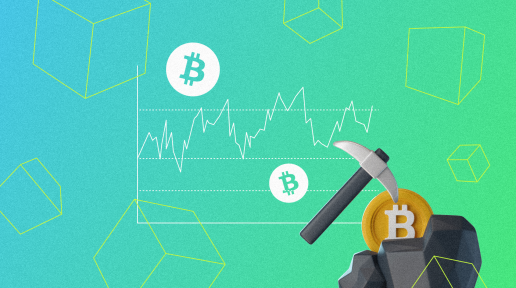A crucial aspect of Bitcoin’s design is known as 'Bitcoin halving,' an event that takes place after every 210,000 blocks are mined, which is roughly every four years. They reduce the reward for mining new blocks by half. This feature is central to Bitcoin's economic model, influencing its scarcity, price, and miners' incentives.
Since Bitcoin’s inception, three halving events have taken place in 2012, 2016, and 2020. Each halving event has been significant in its own way, helping users better understand the complex interplay between technological innovation, market psychology, and economic principles that have come to define the wider crypto market.
In this post, we’ll unpack how each past halving event has impacted Bitcoin and how the 2024 halving could play out for the world’s oldest cryptocurrency.
Analyzing Past Bitcoin Halvings
The 2012 halving
Bitcoin’s first halving event took place at block 210,000 in November 2012 when mining rewards were cut from 50 to 25 bitcoins per block. It was Bitcoin’s first halving event and, as a result, it served as a crucial test for Satoshi Nakamoto’s deflationary design.
While the market’s reaction to the event was relatively subdued, the true impact of the 2012 halving became apparent in the months that followed. A surge in Bitcoin’s price actually catalyzed a wider recognition of Bitcoin’s potential, both as a digital asset and as a revolutionary technology. Ultimately, the awareness brought by the 2012 halving laid the groundwork for Bitcoin’s future growth and adoption.
The 2016 halving
The second Bitcoin halving, which took place at block 420,000 on July 9, 2016 and reduced mining rewards to 12.5 BTC per block, was met with much greater anticipation. The crypto community had seen the potential effects of a halving event and were eager to see if history would repeat itself.
This time around, there was a more pronounced increase in the price of Bitcoin in the months leading up to 2016’s halving, which reflected the growing interest in Bitcoin. However, notable price fluctuations did follow this halving event and tested Bitcoin’s market resilience.
Despite these short-term fluctuations, the longer-term impact of the 2016 halving was profound. It was a pivotal period for Bitcoin’s maturation as an asset class, and a good number of developers were intent on building additional infrastructure and use cases that would demonstrate Bitcoin’s true technological potential.
Bitcoin would actually ride much of that momentum on a historic run that saw it come just short of $20,000 in December 2017. While market moves often don’t convey the whole story, this post-halving surge was crucial in establishing Bitcoin’s reputation as it began to garner mainstream attention and even acceptance.
The 2020 halving
The last halving occurred in May 2020 at block 630,000 and slashed mining rewards to 6.25 BTC per block. By this time, Bitcoin had firmly established itself in the financial world, and the halving was viewed with great interest not just by individual investors and crypto enthusiasts, but also by institutional players. Additionally, the wider crypto community and more mainstream users were getting gradually familiar with developments like the Lightning Network, which fueled their interest and enthusiasm.
The bull market that followed this halving drove Bitcoin to new all-time high prices by the end of 2020 and into 2021. This era underscored Bitcoin's evolving role not just as a digital currency, but as a significant asset in the broader financial and technological landscape.
Analyzing Bitcoin Halving’s Impact on Miners
As we’ve mentioned before, there is typically an increase in Bitcoin’s price in the months leading up to a halving event. Throughout the years, this pattern has emerged due to market speculation and the growing enthusiasm within the crypto community for new developments within the Bitcoin ecosystem. But of course, one of the biggest groups directly affected by Bitcoin halvings are Bitcoin miners.
In many cases, miners often ramp up their activities ahead of a halving event to take advantage of the rewards. This increase in mining activity can sometimes lead to a short-term increase in Bitcoin’s hash rate. Over the years, less efficient miners have often exited the network leading to a temporary drop in hash rate.
However, each Bitcoin halving event has also driven technological innovation in the mining industry. Miners have sought out infrastructure upgrades and more advanced hardware that focus on efficiency to continue their operations. This means that while halving events can pose short-term challenges for miners, they ultimately serve as a catalyst for the evolution of Bitcoin mining in the long-run.
Predictions for the 2024 Bitcoin Halving
The 2024 halving will likely mirror its predecessors in some ways. Similar to the halvings of 2012, 2016 and 2020, we’ll see how the growing institutional adoption of Bitcoin, advancements in blockchain technology, and the evolving policy landscape will influence another milestone in Bitcoin’s history.
But this time, the Bitcoin ecosystem is going into a halving event with a fresh perspective. In the last year, Ordinals have breathed new life into the community, encouraging creators and developers to return to Bitcoin. This, along with the ongoing enthusiasm surrounding the spot Bitcoin ETFs that were approved this year, has given Bitcoin new momentum heading into April.
At that point, the number of blocks will hit 740,000, and a new chapter of Bitcoin’s history will begin.

